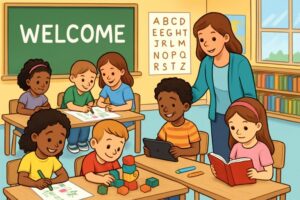Carrer
Engaging Young Minds: Fresh Ways to Foster Creativity in the Classroom
Key Takeaways
- Implementing play-based learning can enhance problem-solving skills and social interactions.
- Integrating technology thoughtfully can personalize learning experiences and boost engagement.
- Outdoor learning adventures provide real-world context and stimulate curiosity.
- Collaborative projects encourage teamwork and diverse perspectives.
- Storytelling and creative expression deepen understanding and foster empathy.
- Mindfulness practices support emotional regulation and focus.
- Involving parents and the community enriches the educational experience.
Table of Contents
- Introduction
- Play-Based Learning
- Integrating Technology Wisely
- Outdoor Learning Adventures
- Collaborative Learning Projects
- Storytelling and Creative Expression
- Mindfulness and Emotional Intelligence
- Parent and Community Involvement

Introduction
Creativity is a vital ingredient for both academic success and lifelong learning. Today’s educators must seek out dynamic methods that spark curiosity and encourage original thinking from an early age. Learning environments that make space for play, innovation, and emotional growth lead to deeper student engagement and help children build skills essential for the future. For classroom inspiration, resources like Studentreasures.com offer a treasure trove of activities and ideas that can be customized for classrooms of all kinds, helping both students and teachers nurture creativity at every stage.
Creativity doesn’t just belong in the art room; it thrives wherever children are empowered to experiment, express themselves, and work collaboratively. When educators blend purposeful play, technology, outdoor experiences, and emotional intelligence, classrooms become hubs of imagination and discovery. As you’ll see below, you can use many actionable strategies immediately to foster a joyful, creative, and connected learning environment.
Play-Based Learning
Play-based learning sits at the heart of effective early years education. Children use play to make sense of the world, testing ideas and boundaries naturally and engagingly. When classroom activities fuse play with academic skills, students grasp core concepts and practice teamwork, communication, and problem-solving. A classroom can transform into a mini-market for role play, where math, language skills, and social interaction unfold organically. Educators who prioritize structured play give children room to ask questions, try different solutions, and explore their imaginations without fear of failure.
Integrating Technology Wisely
While digital distractions are a concern, technology, when woven into the curriculum intentionally, opens up new personalized learning possibilities. Interactive apps enable differentiated instruction so students can progress at their own pace, strengthening confidence and skills. Devices like tablets can host interactive storytelling tools, while coding games introduce the basics of computer science and logical thinking in hands-on ways. Technology should supplement, not replace, traditional activities to maximize benefits, resulting in a balanced educational experience. Educators can consult resources like Edutopia’s Technology Integration Guide for guidance on best practices.
Outdoor Learning Adventures
Stepping outside the classroom brings learning to life, giving academic subjects immediate relevance and real-world context. Nature walks become lessons in biology, weather, and the interconnectedness of ecosystems. Activities like scavenger hunts, gardening, or simple experiments with water and soil make scientific concepts tangible and memorable. Outdoor learning stimulates curiosity, supports physical activity, and encourages observation skills—all crucial for holistic development. City schools can incorporate regular outdoor sessions to connect children to their environment and inspire wonder in everyday surroundings.
Collaborative Learning Projects
Team projects allow students to build interpersonal and conflict resolution skills while working toward common goals. Collaboration nurtures communication, adaptability, and respect for diverse viewpoints, whether creating a mural, producing a group storybook, or tackling a STEM challenge. Educators can set guiding questions or overarching themes—like kindness, community, or sustainability—that tie projects back to core academic areas. These shared endeavors instill a sense of belonging and collective achievement within the classroom.
Storytelling and Creative Expression
Storytelling is a universal way to transmit knowledge, values, and culture. In the classroom, it serves as a springboard for literacy and creative development. Encourage children to invent and tell their own stories through traditional writing, puppetry, drama, or digital media. Story-driven activities help children connect schoolwork with their experiences, boosting engagement and retention. Research shows that linking creative expression to curriculum subjects deepens conceptual understanding and empathy. For more on why narrative matters, visit Scholastic’s insight on the power of storytelling.
Mindfulness and Emotional Intelligence
Self-awareness and emotional regulation are as necessary as academics for student success. Mindfulness exercises—including breathing techniques, guided imagery, or quiet time in a “calm corner”—help children manage stress and stay focused. Building emotional intelligence lays the groundwork for positive relationships and supportive classroom communities. As students gain greater control over their emotions, they become more cooperative, resilient, and open to learning. Simple mindfulness routines can be integrated daily, making emotional health a natural part of school life.
Parent and Community Involvement
Learning doesn’t end at the classroom door. Strong home-school partnerships amplify educational outcomes by weaving together the insights and resources of parents, families, and the broader community. Teachers can invite parents to share stories, lead workshops, or contribute skills, enriching the curriculum with diverse real-world perspectives. Community service projects, shared reading activities, and open communication build lasting connections between school, family, and society, helping children appreciate the broader world while feeling supported in their growth.
Creating a creative classroom means continually exploring new ideas and making every student feel valued and inspired. Educators can light a spark that fuels lifelong curiosity through play, technology, outdoor adventures, collaboration, storytelling, mindfulness, and family engagement. Each strategy is a step toward a classroom where every child feels empowered to create, explore, and thrive.

















